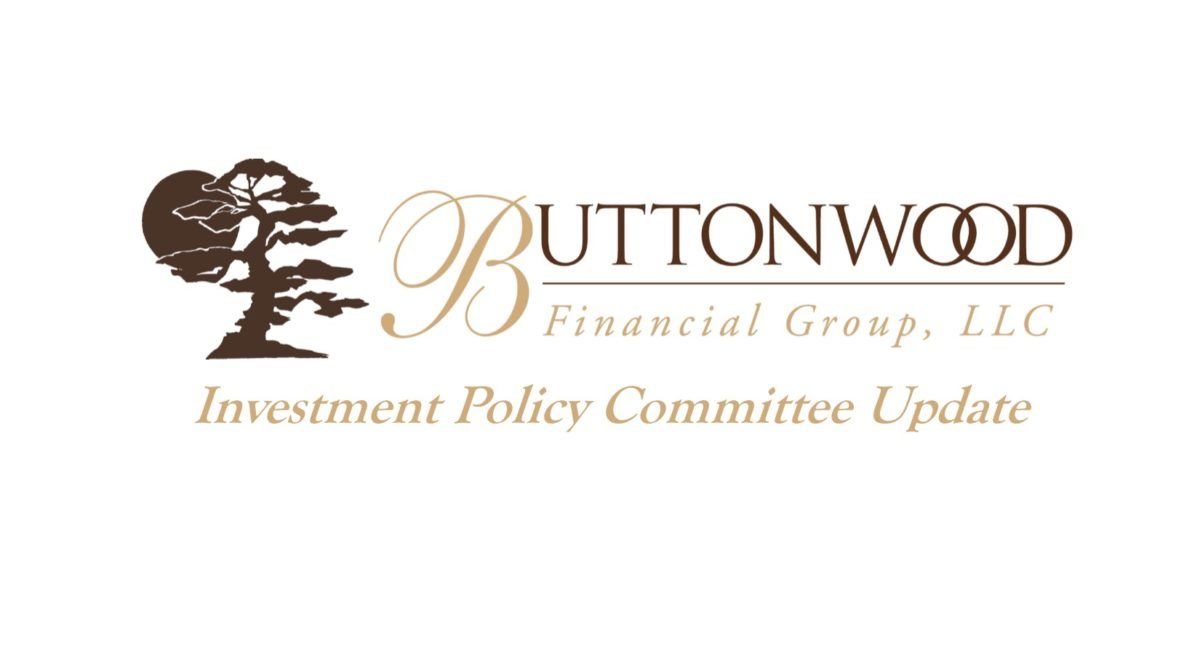Buttonwood Investment Policy Committee Update - October 2022
Inflation has continued to be the dominant theme for market prices and monetary policy throughout 2022. While headline inflation has eased, driven primarily by falling energy prices, core inflation has increased, as the shelter and service components have remained stubbornly sticky (as expected).
In general, we believe inflation trends should ease in the coming months. However, this may not happen as quickly as the market (or the Fed) would like so we may not see real improvement in inflation data until Q1 2023. It is worth noting, that the official inflation data we rely on is some of the most lagged of data we get, not only in terms of when it gets reported but also in terms of what it reflects. Even if economic inflation is declining, we won’t see it in the inflation data for months. For example, the ‘rent’ component of the Consumer Price Index (CPI) has historically followed housing values with a twelve-month lag. The best measure we have of national home values – the Case Shiller US Home Price Index - turned negative in July from its peak in June. But historic lags tell us we won’t see rent inflation or so-called owner equivalent rent inflation of CPI turn negative until next summer. As such, we turn to secondary data sources and see the rental market appears to be loosening. Costar reports rents falling by half a percent in the quarter ending September 30th, 2022.
The persistence of elevated inflation has resulted in a Fed that clearly remains committed to combatting inflation with aggressive rate hikes aimed at reducing both aggregate demand and economic growth. The most recent FOMC minutes showed a continuation of comments reflecting policymakers’ concern about doing too little on inflation rather than too much. The rate increase in October and the increases expected in November and December demonstrate this view, though we think it is important to recognize that this type of monetary policy follow the same trends as inflation data; operating with long and variable lags. For example, we likely won’t see the true impact of lowering economic demand for as long as a year from now, in line with historical observations that monetary policy operates with a ~12-month lag. In our view, so long as the prospect of more rate hikes stays in play, we believe stock market volatility is likely to remain elevated and be a source of uncertainty for investors into 2023.
Remember supply chain backlogs that held back deliveries of new cars because they were all waiting on semiconductor chips? These backlogs were present early in the year, a time when retailers often make decisions for big retailing days like Black Friday and Christmas. We now find ourselves in a market where consumer spending is slowing, investors are shifting preferences from goods back to services, and inventories are likely swollen. Retailers therefore have much less confidence on pricing, and we expect big discounts that can dampen inflation drivers from last year. On the topic of supply chains, we’ve seen easing across the board with one example being ocean freight pricing now at a 2-year low. While last September we all enjoyed quizzing our friends at parties about how it costs $20,000 to ship a container from Asia to the US, as of last Friday the average price for a freight container was $2,720. When we look at measures like Intellectual Property, the Institute of Supply Management, the empire survey, etc. we can see a significant shift in the supply chain issues and the pandemic era drivers of inflation coming down. So, while we feel confident that inflation is likely to be softer a year from now, it will take time for these things to play out. In the near term, however, inflation can remain persistent with ongoing tightening, so there is a very delicate balance that the Fed needs to be conscious about if they don’t want to crush the market.
What to Watch
You may be wondering, with all the risks on the horizon, from a hawkish Fed to earnings expectations downgrades… why not transition the portfolios from defensive to bearish, and go underweight to equites?
We believe there are a few bright spots, one of them being the bullish effect of slowing M2 money growth on stocks. You might remember us discussing M2 in our last trade. As the Fed unwinds its $9T balance sheet, money supply growth (M2) has plunged below the 50yr average, which historically coincides with easing financial conditions.
Given our starting point, characterized by high stock market volatility coupled with falling inflation and tight financial conditions, we believe it is not out of line to expect positive stock returns in the next 12 months. Now, this outcome is entirely dependent on the US economy dodging a recession, not just of the technical kind, but of the NBER kind with far reaching impacts felt throughout the real economy. That is of course a big IF… but a bright spot nonetheless
Positioning Investments
With the continued dance between inflation and recession risks, we feel confident in our defensive positioning, hugging the benchmark with room to step into opportunities as they arise.
We hold equities at benchmark weight, leveling out our growth vs. value bet in US equities, still
overweight US but also adding to low vol Emerging Market stocks. Traditional fixed income is still underweighted vs. bench, as we continue to hold exposure to off bench alts like commodities and convertible bonds. We add to Mortgage-Backed Securities and short dated credit, seeking to add higher spread for minimal risk.
This has been a very difficult year for both individual and institutional investors alike. These are the times to stay disciplined and prudent. We continue to make full use of analytics to stress test portfolios and are carefully watching market dynamics to effectively manage portfolios for what may lie ahead. Our current exposure close to benchmark gives us the opportunity to pivot to add back risk or reposition in the coming months.
In summary we have:
1) Continued to reduce overall risk by moving closer to benchmark in almost all respects:
Is bad news actually bad news or good news? The crosscurrent of elevated inflation and potential downward economic and earnings growth has us concerned. In our view, this environment of unusually limited signal warrants a cautious and mixed (but not outright bearish) approach.
2) We have balanced positions for both potential inflation and recession risks:
Reported inflation remains a top concern for markets. We believe markets have only now begun to focus on recession and earnings risk as well. Our October rebalance further prunes previously existing active views, including bringing our longstanding value tilt and underweight to growth closer to neutral, in part by adding to technology stocks.
3) We are continuing our bias of US assets over International:
After marginally reducing the magnitude of our regional tilts, we remain overweight US stocks with a preference for inflation-sensitive Developed Market stocks and low volatility Emerging Market equities, as international economic and inflation outlooks and central bank policy initiatives diverge from the US.
We will continue to provide ongoing updates on our views and investment positioning. Should you have specific questions about our strategy, please let us know and we will make sure to review details at our next meeting. And while we don’t recommend fixating on short term market fluctuations, if you would like to check specific investment performance across all your accounts, our Buttonwood Portal is available 24/7. Or you can contact us, and we will provide reports specific to your questions and financial life.
Thank you for your continued trust and allowing us to coordinate your asset management as part of our Family CFO services!
Recent Buttonwood Articles

Are you ready to explore the benefits of your very own Family CFO?




